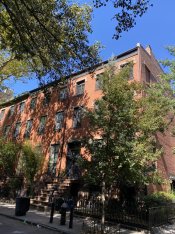-
CLICK HERE To Join Broke Straight Boys & Instantly Get Full Access To Entire Site & 3 FREE bonus sites.
You are using an out of date browser. It may not display this or other websites correctly.
You should upgrade or use an alternative browser.
You should upgrade or use an alternative browser.
What's Life Like in New York City?
- Thread starter tampa24
- Start date
mikeyank
Long time forumite
Thanks guys. I do enjoy sharing my explorations of New York City here.
mikeyank
Long time forumite
I’ve posted this before, but I am continued to be surprised how many people wait on line outside to an unnamed bakery for goodies each morning. Even on the Sunday of Labor Day weekend. One day if the line isn’t too long, I do need to check out what is so good about their pastries to wait on line???
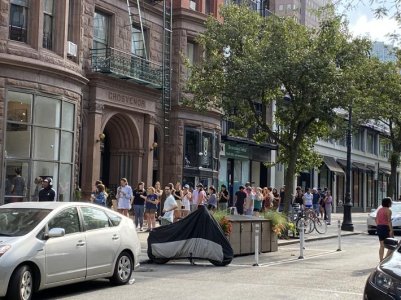

On a separate point, there is a very old unique looking apartment building next door to the bakery in question where etched into the brownstone is the name, “Grosvenor”. I just checked it out online and found a New York Times article from 2002 about The Grosvenor and The Berkeley which is attached to it.
Streetscapes/Montague Street, Brooklyn Heights; Red-Brick Apartment Houses on a Low-Rise Block
“ THE eight-story Queen Anne-style Montague, Berkeley and Grosvenor apartment houses, built together in 1885 at 105, 111 and 115 Montague Street, offer a rich red-brick front to their low-rise street in Brooklyn Heights, with No. 105 very similar but not identical to the joined Nos. 111 and 115. Now Nos. 111-115 are covered in construction scaffolding, as the owner spends more than $1 million on facade repairs.
The boom of tall apartment buildings in Manhattan in the early 1880's produced buildings like the Dakota at 72nd Street and Central Park West and the Chelsea Hotel on West 23rd Street near Seventh Avenue. But it also had its effects in Brooklyn. In 1885 two developers rebuilt sites on Montague Street between Hicks and Henry Streets in what was up to that time an enclave of private houses.
William Ziegler built the Montague, at 105 Montague, and two lots away Henry Weil put up the Berkeley, at No. 111, and the Grosvenor, at No. 115. There is no direct evidence that Ziegler and Weil were partners, but both lived in an older apartment house nearby, they built simultaneously and they used the same architects, the Parfitt Brothers.
According to the architectural historian Andrew Dolkart, Walter and Henry Parfitt were born in England and established an office in Brooklyn around 1875. They first designed typical brownstone rows, but in the early 1880's began experimenting with more picturesque designs, like the Queen Anne-style house in brick and terra cotta at 410 Clinton Avenue, near Gates Avenue. For their Montague Street projects, the Parfitt brothers, joined in 1882 by their brother Albert, developed slightly differing facades. The Montague has a robust granite base with extensive deep red terra cotta ornament, especially near the top, where a male figure peers down from the gable. For the Berkeley and Grosvenor the architects worked the base in rock-faced brownstone and designed the buildings to look as if they were one, with a massive central pier and gable.
The finished structures are in the character of the large Queen Anne-style apartment buildings of the same period in London, where apartment living was more accepted by the well-to-do than in New York. An early advertisement for the Montague said that the lobby had ''decorations by Tiffany'' and noted that its apartments rented for about $100 a month. The Montague was promoted as ''10 minutes from Wall Street,'' and about a third of the tenants listed in the buildings worked in lower Manhattan.” An 1891 article in The Real Estate Record and Guide called the Montague ''the finest of its kind in Brooklyn.'' It noted that Ziegler had taken extensive fireproofing precautions, so that the top floors were both safe and ''the most desirable,'' since they had views over New York Bay. But The Record and Guide also said that the apartment house might soon be converted to a hotel or office building, because Montague Street was becoming ''the Wall Street of Brooklyn'' and office and bank construction on the east end of the street, near what was then City Hall, was beginning to encroach on the residential section toward the west.
Sometime after the turn of the century the Montague was indeed converted to an apartment hotel. A 1902 advertisement promised that the building's dining room was ''prepared to appease the appetite of the epicure,'' and a 1905 photograph showed an elaborate canopy reaching to the curb, with a curved glass top, a type common in the period but no longer seen. The 1920 census recorded 103 households, very few with children. By that time advertisements claimed that the building was ''five minutes from Wall Street. The Berkeley and the Grosvenor were not converted. A news account from the 1920's tells of two tenants, Anna and Augusta Gross, elderly sisters, who were tried for -- and acquitted of -- buying $60,000 worth of smuggled diamonds. Another 1920's tenant, Namer Georges, a linen importer, was attacked in his apartment by an armed robber, Frank Marchese. Mr. Marchese was pursued and captured on the street by several people, including Mr. Georges's chauffeur. The 1930 census showed that apartments in the Berkeley and Grosvenor rented for $65 to $180 a month, and that the tenants included the Rev. Lorin B. Young, a Harvard-trained Episcopal priest at the nearby Church of the Holy Trinity. The next year Mr. Young ran for alderman on the Socialist Party ticket and was arrested with the Socialist leader Norman Thomas for unlawful assembly during a silk workers' strike in Paterson, N.J. The charges were later dismissed.
Another tenant in this period was the lawyer Sarah Stephenson, who, according to her 1945 obituary in The New York Times, in 1904 became the first woman to open a law office in Brooklyn. She was active in women's rights lawsuits, and she applied for membership in the Brooklyn Bar Association over a 30-year period until 1940, when it decided to admit women and permitted her to join.
BY the 1950's this section of Montague Street was no longer posh. In 1952 the Montague was emptied of tenants because of fire code violations, and three years later Joseph Decker, who lived at the Grosvenor, was arrested and charged with being part of a ring of fur robbers. By 1971 the Montague was a welfare hotel, the Brookmont, and The New York Times quoted a 14-year-old boy, unnamed in the article, as saying that ''the mice run right across you when you sleep.''
The apartments in the Montague were stripped of their interior detail no later than 1981, when they were converted to co-ops; the Berkeley and the Grosvenor, still rentals, have also lost the interior detail. The buildings form a powerful presence on this block of Montague Street, which still retains much of its brownstone character and is included in the Brooklyn Heights Historic District.
The Montague's co-op board had the engineer Jay E. Butler complete extensive roof repairs earlier this year. Thomas Graul, a co-president of the board, said that the building needs a facade restoration in the next year or two.
The Berkeley and the Grosvenor are covered in protective black netting in an extensive facade repair and cleaning project. John DiMilia, a partner in the ownership group, said that it had once tried a co-op conversion but that tenant approval had been too difficult to get. ''But thank goodness for that, because it turned out to be such a great investment,'' he said.
He said that most of the 55 apartments are rent-regulated and rent for about $1,000 a month each, but that an unregulated two-bedroom apartment goes for as much as $2,200 a month. The decontrolled apartments make up no more than 15 percent of the total, he said, but the number is growing.
A version of this article appears in print on Nov. 17, 2002, Section 11, Page 9 of the National edition with the headline: Streetscapes/Montague Street, Brooklyn Heights; Red-Brick Apartment Houses on a Low-Rise Block. Order Reprints | Today’s Paper | Subscribe''
————————————————————————————————
According to the above article the apartments rented for about $100 a month back then which sounds very expensive for the late 1800’s. The article goes on to say that “ The 1930 census showed that apartments in the Berkeley and Grosvenor rented for $65 to $180 a month”, and that by the 1970’s the area and the buildings were run down with “rats running across the halls”.
Here are the current rental rates in 2022. Still “very expensive”.
Date Unit Rent Beds Baths ft² Floorplan
08/19/2022 #5A $4,300 2 beds 1 bath 1,000 ft²
06/03/2022 #6B $3,000 1 bed 1 bath 0 ft²
12/23/2021 #3B $2,650 1 bed 1 bath 0 ft²
10/22/2021 #2C $2,850 1 bed 1 bath 0 ft²
05/17/2021 #8A $3,300 2 beds 1 bath 0 ft²
05/05/2021 #3C $2,450 1 bed 1 bath 0 ft²
04/14/2021 #8D $3,300 2 beds 1 bath 0 ft²
03/19/2021 #8B $2,450 1 bed 1 bath 0 ft²
03/15/2021 #4D $3,400 2 beds 1 bath 0 ft²
01/26/2021 #4B $2,650 1 bed 1 bath 0 ft²
—————————————————
I’d only intended to show the two quick pics of the lines outside the bakery, but one thing lead to another. Lol


On a separate point, there is a very old unique looking apartment building next door to the bakery in question where etched into the brownstone is the name, “Grosvenor”. I just checked it out online and found a New York Times article from 2002 about The Grosvenor and The Berkeley which is attached to it.
Streetscapes/Montague Street, Brooklyn Heights; Red-Brick Apartment Houses on a Low-Rise Block
“ THE eight-story Queen Anne-style Montague, Berkeley and Grosvenor apartment houses, built together in 1885 at 105, 111 and 115 Montague Street, offer a rich red-brick front to their low-rise street in Brooklyn Heights, with No. 105 very similar but not identical to the joined Nos. 111 and 115. Now Nos. 111-115 are covered in construction scaffolding, as the owner spends more than $1 million on facade repairs.
The boom of tall apartment buildings in Manhattan in the early 1880's produced buildings like the Dakota at 72nd Street and Central Park West and the Chelsea Hotel on West 23rd Street near Seventh Avenue. But it also had its effects in Brooklyn. In 1885 two developers rebuilt sites on Montague Street between Hicks and Henry Streets in what was up to that time an enclave of private houses.
William Ziegler built the Montague, at 105 Montague, and two lots away Henry Weil put up the Berkeley, at No. 111, and the Grosvenor, at No. 115. There is no direct evidence that Ziegler and Weil were partners, but both lived in an older apartment house nearby, they built simultaneously and they used the same architects, the Parfitt Brothers.
According to the architectural historian Andrew Dolkart, Walter and Henry Parfitt were born in England and established an office in Brooklyn around 1875. They first designed typical brownstone rows, but in the early 1880's began experimenting with more picturesque designs, like the Queen Anne-style house in brick and terra cotta at 410 Clinton Avenue, near Gates Avenue. For their Montague Street projects, the Parfitt brothers, joined in 1882 by their brother Albert, developed slightly differing facades. The Montague has a robust granite base with extensive deep red terra cotta ornament, especially near the top, where a male figure peers down from the gable. For the Berkeley and Grosvenor the architects worked the base in rock-faced brownstone and designed the buildings to look as if they were one, with a massive central pier and gable.
The finished structures are in the character of the large Queen Anne-style apartment buildings of the same period in London, where apartment living was more accepted by the well-to-do than in New York. An early advertisement for the Montague said that the lobby had ''decorations by Tiffany'' and noted that its apartments rented for about $100 a month. The Montague was promoted as ''10 minutes from Wall Street,'' and about a third of the tenants listed in the buildings worked in lower Manhattan.” An 1891 article in The Real Estate Record and Guide called the Montague ''the finest of its kind in Brooklyn.'' It noted that Ziegler had taken extensive fireproofing precautions, so that the top floors were both safe and ''the most desirable,'' since they had views over New York Bay. But The Record and Guide also said that the apartment house might soon be converted to a hotel or office building, because Montague Street was becoming ''the Wall Street of Brooklyn'' and office and bank construction on the east end of the street, near what was then City Hall, was beginning to encroach on the residential section toward the west.
Sometime after the turn of the century the Montague was indeed converted to an apartment hotel. A 1902 advertisement promised that the building's dining room was ''prepared to appease the appetite of the epicure,'' and a 1905 photograph showed an elaborate canopy reaching to the curb, with a curved glass top, a type common in the period but no longer seen. The 1920 census recorded 103 households, very few with children. By that time advertisements claimed that the building was ''five minutes from Wall Street. The Berkeley and the Grosvenor were not converted. A news account from the 1920's tells of two tenants, Anna and Augusta Gross, elderly sisters, who were tried for -- and acquitted of -- buying $60,000 worth of smuggled diamonds. Another 1920's tenant, Namer Georges, a linen importer, was attacked in his apartment by an armed robber, Frank Marchese. Mr. Marchese was pursued and captured on the street by several people, including Mr. Georges's chauffeur. The 1930 census showed that apartments in the Berkeley and Grosvenor rented for $65 to $180 a month, and that the tenants included the Rev. Lorin B. Young, a Harvard-trained Episcopal priest at the nearby Church of the Holy Trinity. The next year Mr. Young ran for alderman on the Socialist Party ticket and was arrested with the Socialist leader Norman Thomas for unlawful assembly during a silk workers' strike in Paterson, N.J. The charges were later dismissed.
Another tenant in this period was the lawyer Sarah Stephenson, who, according to her 1945 obituary in The New York Times, in 1904 became the first woman to open a law office in Brooklyn. She was active in women's rights lawsuits, and she applied for membership in the Brooklyn Bar Association over a 30-year period until 1940, when it decided to admit women and permitted her to join.
BY the 1950's this section of Montague Street was no longer posh. In 1952 the Montague was emptied of tenants because of fire code violations, and three years later Joseph Decker, who lived at the Grosvenor, was arrested and charged with being part of a ring of fur robbers. By 1971 the Montague was a welfare hotel, the Brookmont, and The New York Times quoted a 14-year-old boy, unnamed in the article, as saying that ''the mice run right across you when you sleep.''
The apartments in the Montague were stripped of their interior detail no later than 1981, when they were converted to co-ops; the Berkeley and the Grosvenor, still rentals, have also lost the interior detail. The buildings form a powerful presence on this block of Montague Street, which still retains much of its brownstone character and is included in the Brooklyn Heights Historic District.
The Montague's co-op board had the engineer Jay E. Butler complete extensive roof repairs earlier this year. Thomas Graul, a co-president of the board, said that the building needs a facade restoration in the next year or two.
The Berkeley and the Grosvenor are covered in protective black netting in an extensive facade repair and cleaning project. John DiMilia, a partner in the ownership group, said that it had once tried a co-op conversion but that tenant approval had been too difficult to get. ''But thank goodness for that, because it turned out to be such a great investment,'' he said.
He said that most of the 55 apartments are rent-regulated and rent for about $1,000 a month each, but that an unregulated two-bedroom apartment goes for as much as $2,200 a month. The decontrolled apartments make up no more than 15 percent of the total, he said, but the number is growing.
A version of this article appears in print on Nov. 17, 2002, Section 11, Page 9 of the National edition with the headline: Streetscapes/Montague Street, Brooklyn Heights; Red-Brick Apartment Houses on a Low-Rise Block. Order Reprints | Today’s Paper | Subscribe''
————————————————————————————————
According to the above article the apartments rented for about $100 a month back then which sounds very expensive for the late 1800’s. The article goes on to say that “ The 1930 census showed that apartments in the Berkeley and Grosvenor rented for $65 to $180 a month”, and that by the 1970’s the area and the buildings were run down with “rats running across the halls”.
Here are the current rental rates in 2022. Still “very expensive”.
Date Unit Rent Beds Baths ft² Floorplan
08/19/2022 #5A $4,300 2 beds 1 bath 1,000 ft²
06/03/2022 #6B $3,000 1 bed 1 bath 0 ft²
12/23/2021 #3B $2,650 1 bed 1 bath 0 ft²
10/22/2021 #2C $2,850 1 bed 1 bath 0 ft²
05/17/2021 #8A $3,300 2 beds 1 bath 0 ft²
05/05/2021 #3C $2,450 1 bed 1 bath 0 ft²
04/14/2021 #8D $3,300 2 beds 1 bath 0 ft²
03/19/2021 #8B $2,450 1 bed 1 bath 0 ft²
03/15/2021 #4D $3,400 2 beds 1 bath 0 ft²
01/26/2021 #4B $2,650 1 bed 1 bath 0 ft²
—————————————————
I’d only intended to show the two quick pics of the lines outside the bakery, but one thing lead to another. Lol
On a separate point, there is a very old unique looking apartment building next door to the bakery in question where etched into the brownstone is the name, “Grosvenor”. I just checked it out online and found a New York Times article from 2002 about The Grosvenor and The Berkeley which is attached to it.
I have heard of The Grosvenor.
I have heard of The Grosvenor.
mikeyank
Long time forumite
I was planning to post pics on this thread tomorrow when I go on a walking tour of the unique Brooklyn neighborhood of Bushwick, which I still intend to do. However today being a spectacular late summer day, I decided it was a good day to walk to my Post office to pick up some stamps. Most of my bill paying is done electronically but I do have occasion to pay a doctor a co-pay by check or to send a greeting card to a family member or a friend for which I do need stamps.
It is a ten minute walk to my local post office, and I walked past Brooklyn Borough Hall, which used to be The Brooklyn City Hall when Brooklyn was a separate city before 1898 when they merged with Manhattan, Queens and The Bronx.
Here are some pics I took this afternoon of Borough Hall, an old renovated subway kiosk with an elevator ride down to the subway, Columbus Park where The Supreme Court of New York State is with a statue of Christopher Columbus, and also a statute of abolitionist Henry Ward Beecher and a new art installation all in Columbus Park Which I took today.








It is a ten minute walk to my local post office, and I walked past Brooklyn Borough Hall, which used to be The Brooklyn City Hall when Brooklyn was a separate city before 1898 when they merged with Manhattan, Queens and The Bronx.
Here are some pics I took this afternoon of Borough Hall, an old renovated subway kiosk with an elevator ride down to the subway, Columbus Park where The Supreme Court of New York State is with a statue of Christopher Columbus, and also a statute of abolitionist Henry Ward Beecher and a new art installation all in Columbus Park Which I took today.








mikeyank
Long time forumite
I did walk next to Columbus Park then to purchase my stamps. My local post office is now a smaller version of The U.S. General Post Office opened in 1892. The building today is a multi-purpose building but is a spectacular architectural masterpiece. I discovered a little museum inside the post office with some history as well.


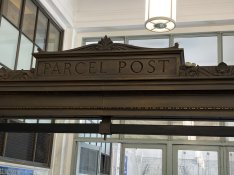


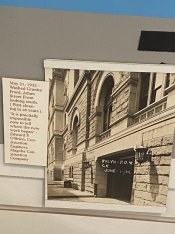






mikeyank
Long time forumite
I was on a walking tour of Bushwick, Brooklyn today. It was once a thriving industrial area filled with factories. When industry moved out of the city, the neighborhood became a drug infested, crime riddled, dangerous neighborhood. Over the last 25-30 years young artists began moving into the abandoned warehouses and street art has covered the buildings. Today the neighborhood has a hip young vibe with art galleries as well as music venues, restaurants and performance spaces.
Here are some pics I took this afternoon on another clear sunny late summer afternoon in New York City.


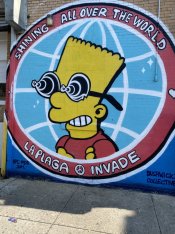





Here are some pics I took this afternoon on another clear sunny late summer afternoon in New York City.








mikeyank
Long time forumite
The first picture in this group is a street artist we saw actually painting a mural on a construction crane with spray paint in hand. The rest in this group is an actual house in which four young artists live in and today was open house and we walked through their house and watched them create art and toured their art filled house from living space to kitchen. Very cool indeed!












Could not agree more. Thank you, thank you, thank you my beloved friend Mike.Awesome pictures!! Thanks for the continued tours of NYC!
mikeyank
Long time forumite
mikeyank
Long time forumite
Similar threads
- Replies
- 8
- Views
- 889
- Replies
- 5
- Views
- 1K















